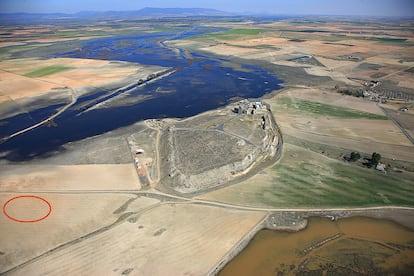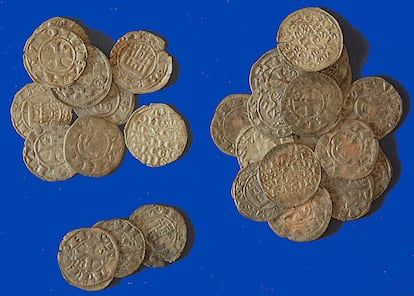Calatrava la Vieja: the ancient Spanish city of the four hidden treasures
Archeologists have pieced together part of the history of finds made around the walls of a town that was a frontier fortress during the medieval wars between Muslims and Christians


The old saying “there is nothing more cowardly than money” has curiously become a genuine archeological treasure trove and an inexhaustible source of knowledge for experts.
A recent article, Calatrava la Vieja’s hidden coins. Secret treasures of the past, co-authored by the archeologist Manuel Retuerce Velasco of the department of Pre-History, Archeology and Ancient History at Madrid’s Complutense University, and by Miguel Hervás Herrera of the specialized consultancy Baraka, details the discovery over the past few decades of four stashes of coins at a site in modern-day Carrión de Calatrava, in Spain’s Ciudad Real province, which were presumably hidden by their owners against the imminent threat of conflict.
Two of them pertain to the age of the Muslim emirs in Spain in the ninth century. The fortified town of Calatrava la Vieja was for four centuries the most notable point between Toledo and Córdoba, and it sat on the frontier between Christian and Muslim territories. The other two troves date from the 13th century.
The article penned by Retuerce and Hervás explains: “As a result of the fear sown by men with their frequent warlike actions, at times of insecurity it was normal and logical for the assets of any member of the community to be hidden. Until the danger had passed, people would frequently attempt to hide their money and belongings at a predetermined place relatively close to where they lived.”

From 1960 when the first discovery was made by chance, until 2010 when the latest hoard of coins was uncovered, archeologists have been gaining greater knowledge of day-to-day life in the ancient walled city of Calatrava la Vieja, which was estimated to have a population of around 4,000 people up to the end of the 13th century. From there it started to fall into progressive decline as its strategic and military importance ebbed when the front line of the war between Christians and Muslims in Spain was pushed further south during the final stages of the Reconquest.
In 1960, 24 years before archeological digs began in Carrión de Calatrava, a farmer stumbled upon a stash of over 100 coins dating back to the ninth century in what would have been the eastern edge of the city. However, researchers have little information about the discovery because almost all of the coins were sold by their finder. There is also scant information about the container they were kept in, which is the key for researchers to determine why troves were hidden. Only five of the coins were donated to the National Archeological Museum in Madrid.
The second find came about in 1995 during construction work near a septic tank around 100 meters southeast of a shrine near the first site. The discovery contained 400 grams of silver coins from the reigns of “all of the Umayyad Emirs of al-Andalus [the Muslim-ruled area of the Iberian peninsula], from Abd al-Rahman I to Abd Allah; a few fragments of Frankish coins, two coins from other Islamic dynasties and two small pieces of silver jewelry.”
It is believed that this hoard belonged to someone who hid their wealth to keep it from enemies descending on the city. The chronology of the coins covers more than 100 years, from the late 700s to 891 or 892 during the reign of Emir Abd Allah (888-912), who was the grandfather of the future Caliph of Córdoba Abd al-Rahman III. This find is on display at the Provincial Museum of Ciudad Real.
But not all of the discoveries in the area were accidental. In 2004, while archeologists were working beyond the walls of the ancient town, north of its imposing alcázar fortress, they found 71 coins dating from the reign of Alfonso VIII in what they believe was the floor of a suburban dwelling. Because of its characteristics – with fragments of cloth used to cover them and the low value of the coins – the experts think the stash could have been hidden in a beam in the roof that fell to the floor when the house collapsed. The find is dated to between 1212 and 1217 and the monetary value of the coins represents approximately a month’s wages at the time.
The last find, uncovered in 2010 just eight meters from the previous one, is very similar. The only difference is that the archeologists are absolutely certain as to how this trove of 29 coins was hidden. They were minted between the end of the 12th century and 1264, the later ones during the reign of Alfonso X of Castile as a result of his war against the Emirate of Granada.
This hoard was found wrapped in cloth on what would have been the floor of a 13th-century dwelling. “It was hidden between the timbers of one of the beams in the roof of the room,” says Retuerce. “Perhaps these coins were hidden in that spot and remained there forever: as nobody ever recovered them, once the house was abandoned and later fell apart, when the walls and ceiling collapsed, they fell to the floor.”
“The four troves of Calatrava la Vieja are a clear example of how movable fortunes were hidden in secret places,” concludes Retuerce.” These places were only known to the fearful or presaging owner of the property and to people who were close confidants. When the danger had passed and the attackers had dispersed, only they or members of their family would try to return to recover the hidden loot. The unfortunate truth is that on many occasions none of the people who knew its whereabouts would survive an attack, nobody would return for the secret stash and it would remain in the same place for centuries and centuries…”
English version by Rob Train.
Tu suscripción se está usando en otro dispositivo
¿Quieres añadir otro usuario a tu suscripción?
Si continúas leyendo en este dispositivo, no se podrá leer en el otro.
FlechaTu suscripción se está usando en otro dispositivo y solo puedes acceder a EL PAÍS desde un dispositivo a la vez.
Si quieres compartir tu cuenta, cambia tu suscripción a la modalidad Premium, así podrás añadir otro usuario. Cada uno accederá con su propia cuenta de email, lo que os permitirá personalizar vuestra experiencia en EL PAÍS.
¿Tienes una suscripción de empresa? Accede aquí para contratar más cuentas.
En el caso de no saber quién está usando tu cuenta, te recomendamos cambiar tu contraseña aquí.
Si decides continuar compartiendo tu cuenta, este mensaje se mostrará en tu dispositivo y en el de la otra persona que está usando tu cuenta de forma indefinida, afectando a tu experiencia de lectura. Puedes consultar aquí los términos y condiciones de la suscripción digital.
More information
Archived In
Últimas noticias
Most viewed
- Sinaloa Cartel war is taking its toll on Los Chapitos
- Oona Chaplin: ‘I told James Cameron that I was living in a treehouse and starting a permaculture project with a friend’
- Reinhard Genzel, Nobel laureate in physics: ‘One-minute videos will never give you the truth’
- Why the price of coffee has skyrocketed: from Brazilian plantations to specialty coffee houses
- Silver prices are going crazy: This is what’s fueling the rally









































